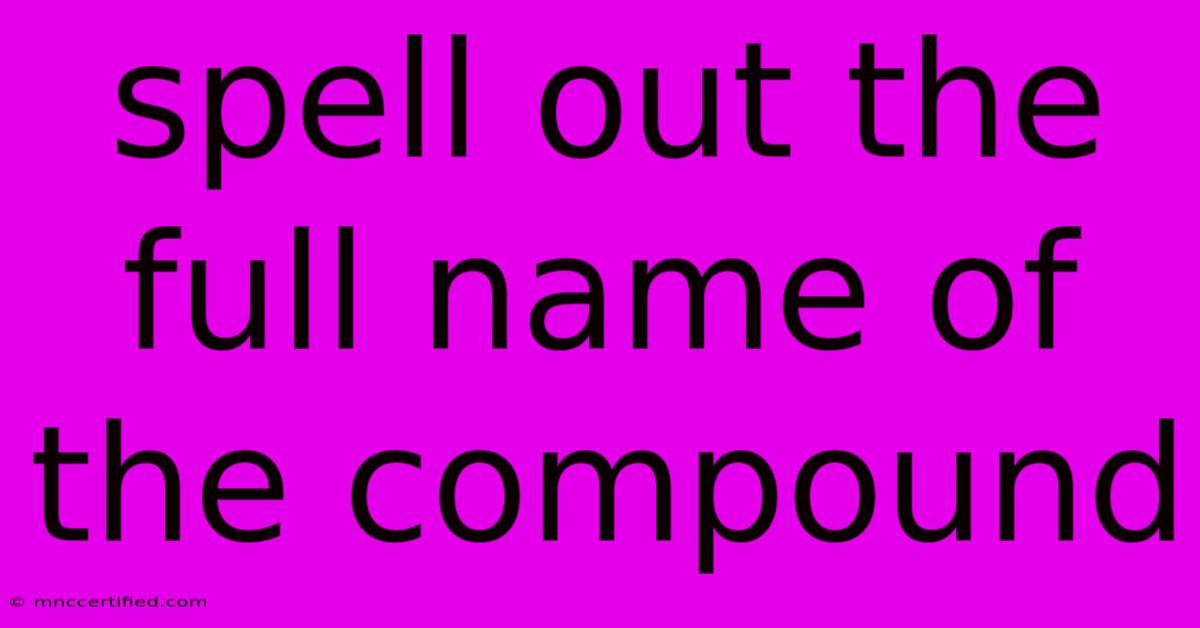Spell Out The Full Name Of The Compound

Table of Contents
Decoding Chemical Compounds: How to Spell Out Full Names
In the world of chemistry, compounds are often represented by their shorthand formulas, like H₂O for water. While these formulas are convenient for quick reference, sometimes it's necessary to spell out the full name of a compound for clarity and better understanding. This guide will help you master the art of deciphering those chemical formulas and translating them into their full, descriptive names.
The Building Blocks: Elements and Their Names
Before diving into compounds, it's crucial to know the names of the elements that compose them. The periodic table is your go-to resource for this information. Each element has a unique symbol (e.g., H for hydrogen, O for oxygen) and a corresponding name.
The Art of Naming Simple Compounds
Binary Compounds: Two Elements Unite
For compounds made up of two elements, the general rule is to name the more metallic element first, followed by the less metallic element. The less metallic element takes an "-ide" ending. Here are some examples:
- NaCl: Sodium chloride (Sodium is more metallic than chlorine)
- KBr: Potassium bromide
- CaO: Calcium oxide
Special Cases: Transition Metals
Transition metals (elements in the middle of the periodic table) can form multiple ions with varying charges. To indicate the specific charge in a compound, Roman numerals are used in parentheses after the metal's name.
- FeCl₂: Iron(II) chloride (Iron has a +2 charge)
- FeCl₃: Iron(III) chloride (Iron has a +3 charge)
Polyatomic Ions: Groups of Elements Working Together
Polyatomic ions are groups of atoms that act as a single unit with a specific charge. These ions have their own unique names that must be learned.
- NH₄⁺: Ammonium
- SO₄²⁻: Sulfate
- NO₃⁻: Nitrate
When combining polyatomic ions with other elements, the same rules for naming binary compounds apply.
- (NH₄)₂SO₄: Ammonium sulfate
- NaNO₃: Sodium nitrate
Acids: Sour and Specific
Acids are compounds containing hydrogen (H⁺) that release it in solution. Naming acids depends on whether they contain oxygen:
- Binary Acids (no oxygen): The prefix "hydro-" is added before the nonmetal name, followed by "-ic acid".
- Oxoacids (contain oxygen): The name is based on the nonmetal's anion. If the anion ends in "-ite," the acid name ends in "-ous acid." If the anion ends in "-ate," the acid name ends in "-ic acid."
Here are some examples:
- HCl: Hydrochloric acid
- H₂SO₄: Sulfuric acid (from the sulfate ion)
- HNO₃: Nitric acid (from the nitrate ion)
Navigating Complex Compounds
For larger and more complex compounds, you might encounter prefixes like "mono-", "di-", "tri-", and so on. These prefixes indicate the number of atoms of each element present.
- CO: Carbon monoxide (one carbon, one oxygen)
- CO₂: Carbon dioxide (one carbon, two oxygen)
- P₂O₅: Diphosphorus pentoxide (two phosphorus, five oxygen)
Utilizing Online Resources
Several helpful online tools and websites can aid in determining the full names of compounds. Some popular options include:
- PubChem: https://pubchem.ncbi.nlm.nih.gov/
- ChemSpider: https://www.chemspider.com/
- Wolfram Alpha: https://www.wolframalpha.com/
These websites allow you to input a chemical formula or name and retrieve information about the compound, including its full name.
Practice Makes Perfect
Mastering the art of spelling out compound names requires practice. By regularly reviewing the rules and using online resources, you'll build confidence and become proficient at deciphering the chemical language of compounds.
Remember, the journey of understanding chemistry is an ongoing process. Embrace the challenge of learning new names and formulas, and your appreciation for the world of chemical compounds will grow.

Thank you for visiting our website wich cover about Spell Out The Full Name Of The Compound . We hope the information provided has been useful to you. Feel free to contact us if you have any questions or need further assistance. See you next time and dont miss to bookmark.
Featured Posts
-
Manufacturers Alliance Insurance Company
Nov 07, 2024
-
Shetland Alison O Donnell Reacts To Episode 1 Twist
Nov 07, 2024
-
Stranger Things Season 5 What We Know
Nov 07, 2024
-
Trump Win Impact On Israel And Ukraine Conflicts
Nov 07, 2024
-
Contingency Insurance For Freight Brokers
Nov 07, 2024